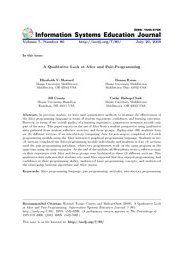Volume 7
Volume 7, Number 80 |
July 20, 2009 |
Abstract: In previous studies, we have used quantitative methods to examine the effectiveness of the Alice programming language in terms of student enjoyment, confidence, and learning outcomes. However, in terms of the overall quality of a learning experience, quantitative measures provide only part of the story. This paper reports on the use of Alice from a student perspective using qualitative data gathered from student reflective exercises and focus groups. Eighty-nine (89) students from six (6) different sections of an introductory computing class for non-majors completed a 2.5-week programming module using the Alice interactive graphical programming language. Students in two (2) sections completed the Alice programming module individually and students in four (4) sections used the pair-programming paradigm, where two programmers work on the same program at the same time using the same computer. At the end of the module, all 89 students wrote a reflective essay on their experience with Alice and focus groups were facilitated in three (3) different sections. This qualitative data indicates that students who used Alice reported that they enjoyed programming, had confidence in their programming ability, understood basic programming concepts, and understood the relationship between algorithms and Alice stories.
Keywords: Alice programming language, pair-programming, attitudes, introductory programming
Download this issue: ISEDJ.7(80).Howard.pdf (Adobe PDF, 10 pages, 591 K bytes)
Preview the contents: Howard.j.txt (ASCII txt, 25 K bytes)
Recommended Citation: Howard, Evans, Courte, and Bishop-Clark (2009). A Qualitative Look at Alice and Pair-Programming. Information Systems Education Journal, 7 (80). http://isedj.org/7/80/. ISSN: 1545-679X. (A preliminary version appears in The Proceedings of ISECON 2006: §2342. ISSN: 1542-7382.)
